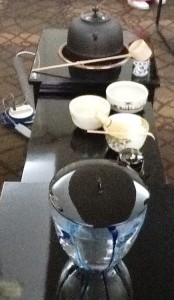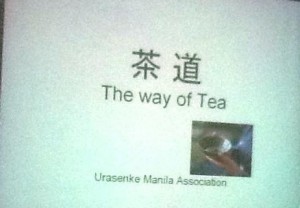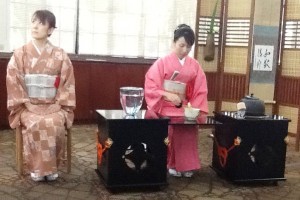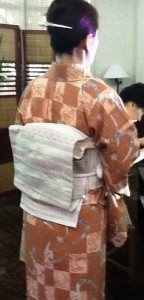 This week I witnessed a Japanese Tea Ceremony hosted by the Urasenke Manila Association at the Filipino Heritage Library. It was a fascinating, absorbing occasion, and one I felt honoured to attend.
This week I witnessed a Japanese Tea Ceremony hosted by the Urasenke Manila Association at the Filipino Heritage Library. It was a fascinating, absorbing occasion, and one I felt honoured to attend.
Tea first arrived in Japan from China in approximately 500 AD, since when the tea ceremony has gradually evolved. Today it is a solemn ritual steeped in centuries of tradition.
As we entered the library, three ladies in kimonos were setting up a table at the front of the room. Small china bowls and a cast iron pot of boiling water were placed just so. A bamboo whisk, a cross between an egg whisk and a shaving brush, stood beside a black lacquer tea caddy. A wooden screen bore a cornucopia-shaped basket of seasonal leaves and flowers.
Yuko Yamahura stood to give us a running commentary, as we watched a short film of a teenage girl attending her first tea ceremony with her mother in a real tea house. Following a peaceful path through the garden they reach the tiny house amongst the trees. Here, they left dignity on the doorstep to clamber – somehow gracefully – through a small window-like opening into the tea house. Kneeling on the traditional matting, they are greeted by their host, and the rest of the ceremony is conducted in silence.
While I could not expect to comprehend all the intricacies of this ritualistic tea party after only one morning, I am in awe of the level of quiet self-control and calmly orchestrated ceremony. Each step is performed with gentle deliberation and measured movements. Somehow the winged sleeves of the kimono do not trail through the tea, nothing is spilled, and the bowls of tea are handed out to guests with calm assurance.
 Apparently such discipline and harmony is at the core of the ceremony. The Way of Tea was developed in Japan by Sen Rikyuu (1522-1591). The tea ceremony is known as Sadou, which indicates spiritual and mental discipline, harmony and tranquility, and respectful communication. Ichigo Ichie means one encounter, one opportunity to share these principles with guests.
Apparently such discipline and harmony is at the core of the ceremony. The Way of Tea was developed in Japan by Sen Rikyuu (1522-1591). The tea ceremony is known as Sadou, which indicates spiritual and mental discipline, harmony and tranquility, and respectful communication. Ichigo Ichie means one encounter, one opportunity to share these principles with guests.
Our hostesses then began the ceremony, while one of them talked us quietly through each step.
A gong will announce that it is time for tea. Part one is more formal. A thick tea – koicha – is served in respectful silence to guests, preceded by a light meal – kaiseki – something sweet to balance the bitter tea. This tea is deep pea green and the consistency of potato soup, with a somewhat grassy flavour. Guests share this bowl, turning it slowly each time it moves on to the next person, to politely avoid sharing the same part of the bowl’s lip.
Later, the bowl of thick tea is replaced by individual bowls of lighter tea. We watched one lady perform the ceremony of making tea at a small lacquered table. (It is usually made and served from a mat on the floor, everyone kneeling for up to four hours, but our more western knees were accommodated on chairs.)
 A deep, cup-sized bowl was wiped clean in a slow, circular motion with a clean cloth. Once polished, a scoop of green tea powder was taken from the black lacquered caddy and placed gently into the bowl. Then, carefully removing the hot lid of the kettle with another cloth, neatly folded, the steaming hot water was gently poured onto the tea with a small bamboo ladle. The bamboo whisk was then taken up to stir the tea in controlled circular motions, no doubt a pre-designated number of times.
A deep, cup-sized bowl was wiped clean in a slow, circular motion with a clean cloth. Once polished, a scoop of green tea powder was taken from the black lacquered caddy and placed gently into the bowl. Then, carefully removing the hot lid of the kettle with another cloth, neatly folded, the steaming hot water was gently poured onto the tea with a small bamboo ladle. The bamboo whisk was then taken up to stir the tea in controlled circular motions, no doubt a pre-designated number of times.
 Another beautifully dressed hostess then carried the cup slowly to the first guest. (I doubt it would be possible to walk swiftly in traditional Japanese footwear.) The guest thanked her, remarked to the other guests that she has received her tea first and would drink it now, and proceeded to turn the cup again. This time the cup is turned, not because it will be shared, but because each cup has an individual beauty spot that becomes a point of focus during the ceremony. This spot will face the guest when it is handed to her. The guest must admire it, and then turn it respectfully away to drink from the less precious side of the cup.
Another beautifully dressed hostess then carried the cup slowly to the first guest. (I doubt it would be possible to walk swiftly in traditional Japanese footwear.) The guest thanked her, remarked to the other guests that she has received her tea first and would drink it now, and proceeded to turn the cup again. This time the cup is turned, not because it will be shared, but because each cup has an individual beauty spot that becomes a point of focus during the ceremony. This spot will face the guest when it is handed to her. The guest must admire it, and then turn it respectfully away to drink from the less precious side of the cup.
And the ceremony continues until all the guests have their tea. This part of the ceremony is less formal though, and general conversation may accompany it.
In my own life, this formality compares a little to the Christian ritual of Holy Communion. As with all rituals there is an element of meditation through the solemnity of pre-ordained process, protocol and repetition.
 I came away feeling almost serene, not a natural state for me, I hasten to add. I found myself walking slowly, opening doors carefully, not rushing. Yet at the same time, such contained movements made me feel claustrophobic, almost as if I hadn’t breathed for the entire ceremony. It was an extraordinary feeling of juxtaposition: calm and contained frustration in one body.
I came away feeling almost serene, not a natural state for me, I hasten to add. I found myself walking slowly, opening doors carefully, not rushing. Yet at the same time, such contained movements made me feel claustrophobic, almost as if I hadn’t breathed for the entire ceremony. It was an extraordinary feeling of juxtaposition: calm and contained frustration in one body.
I am inclined to practice such control at home, to save all those broken dishes and bruises accumulated on my usual dash through life, but it will probably take years of perseverance and self-discipline, and I suspect it will be like watching paint dry. I may just have to leave it to the experts…

A bit different from my tea ceremony :
Bleary eyed I whack the kettle on the hotplate after stumbling downstairs in disgust at my piercing morning alarm. In goes the Lipton tea bag into the mug until the kettle hollers for attention much like a frantic freight train emerging from a tunnel desperately needing attention (why do I drift away from the kitchen when I know I will be unceremoniously ordered back by the kettle!) Water, dangle, dip and dunk, then toss the soggy tea sachet into the smelly garbage (oops forgot to empty it last night). Whacko the didlio – a hot cuppa to start the day. Aaah 🙂
It’s still good even after you have reheated it twice in the microwave and the kids have finally left for school!!
Whacko the chook as well! Here’s to an electric kettle that doesn’t whistle AND turns itself off. Wish the toaster would too, before the bread burns. And the milk I was boiling for the coffee, not to drown the top of the stove…